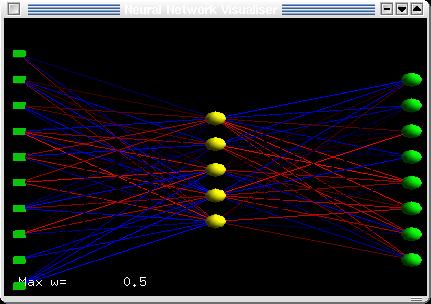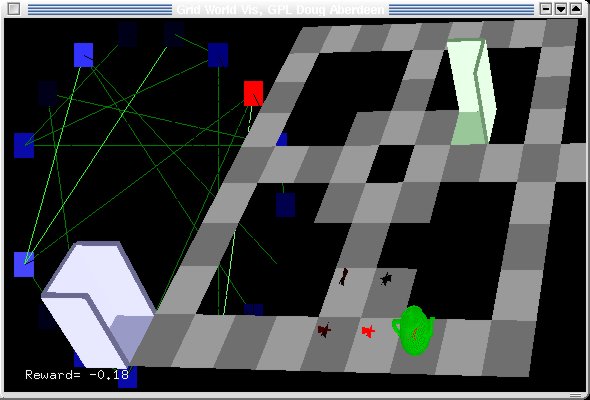 About me
About me
 Contact me
Contact me
 My research
My research
 Courses
Courses
 Humour
Humour
 Fencing
Fencing
 Quote for the Day
Quote for the Day
 Home
Home
You've come to Doug Aberdeen's old pages. In 5 seconds you will taken to my new pages http://sml.nicta.com.au/~daa/
Source code
These tar balls are in various states of repair. They all have readme files and the source is more or less documented, but the only one with a proper manual is dlib. Please email me if you are interested in using this stuff. If there is enough interest I will make the distributions a little more friendly. Some of it is related to my Ph.D research, other stuff is just for fun.Emmerald
Emmerald Source Code and Libraries. Requries libcblas.a All the source code for the Linux SIMD SGEMM referred to in the Emmerald paper. If you're interested in a BLAS library which uses SIMD features, check out ATLAS. Emmerald may be faster if you have large common dimensions.
DHMM
Source code for HMM training and classification and discriminative HMM training and classification. This is pretty primitive in terms of documentation, so if you're interested in some better stuff, email me. If you're not using a linux box you'll have to d'load and make dlib (below) too.
dlib
Source code for my intermediate level C library dlib. Includes typed config file parsing, hash tables, warning and error mechanisms, memory usage, matrix classes for 3d transforms, linked lists and Red Black trees. All routines are individually documented in an API file and examples of all the construct usages are given. If anyone is interested, I'll consider writing better documentation.
This page describes how to set up your PIII Linux box for SSE instructions and has test code to verify correct operation.
id3-eiffel.tgz
An implementation of the ID3 Decision Tree Algorithm written in Eiffel for novelty value.
Particle Filter demo
A simple OpenGL particle filter demo, variable number of particles track an object
zooming around randomly in a box. It's easy to edit the physical simulation and the
particle filter algorithm. Requires OpenGL or Mesa, GLU and GLUT libraries.
Demo in .tar.gz file
GLANND
An Open GL visualiser for Artificial Neural nets. Gives you a pretty NN picture in 3D with pan, zoom, rotate. The weights are shown as different shades of blue (negative) and red (positive). Fairly primitive but produces some cute pictures. Will read the weights from a single precision binary file and the layer, squashing function description is given on the command line. Can also be plugged into an ANN trainer using shared memory.

GridView
An Open GL visualiser for control in gridworld style environments. Allows you to visualise the policy of a learning agent. Features include:
o Allows an arbitrary number of states which are arranged in a 2D grid to be specified and rendered. o Renders the current position of the agent in the 2D world. o Two agent types can be used. o Agents can be turned to one of 8 directions for worlds where actions are "turn" or "move". o Obstacles can be placed and optionally rendered on any side of any state. o The path an agent takes can be displayed with a set of fading arrows, where the rate of fade can be set to the discount the factor used in training. Path rendering can be turned on or off. o The renderer provides a timer and a callback to update the state every few ms (adjustable through the interface). o The scene can be spun, zoomed and panned.

Drop down capitals in fancy font for LaTeX
Drop down those fancy gothic captial letters in a LaTeX document. You'll need the standard yinit font and wrapfig style. Here's what it looks like: dropcapsex.pdf .
Roman numeral keys LaTeX list environment.
Make your key points clearly with a list environment that enumerates points with key shapes where each key tooth is a roman number of the point. It looks like: keyex.pdf . You'll also need hhcount.sty and hhutils0.sty.
ICAPS '04 Planning Software to go with ICAPS 04 paper "Decision-Theoretic Military Operations Planning".
A generic implementation of Real Time Dynamic Programming, plus a specific application to operations planning. Examples provided are for military operations planning, as described in the paper. Source is provided as-is.. no fancy installation scrips.
Original GPOMDP code to go with quite a few papers including Jonathan Baxter's policy-gradient papers.
This code is provided as is. It is not supported in any way. It should be an interesting reference for people that want to implement their own policy-gradient code, but it is not recommended for further development.

 The views and opinions expressed on this web page are not necessarily
those of NICTA or the Australian National University.
Any HTML or image from this page may be copied and re-used freely but
must not be sold.
Feedback:Doug.Aberdeen AT anu.edu.au
The views and opinions expressed on this web page are not necessarily
those of NICTA or the Australian National University.
Any HTML or image from this page may be copied and re-used freely but
must not be sold.
Feedback:Doug.Aberdeen AT anu.edu.au

